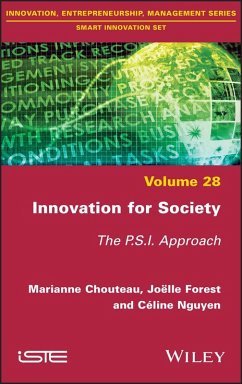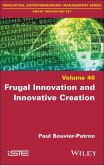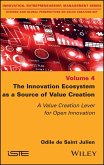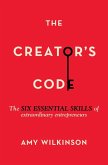Innovation for Society (eBook, ePUB)
The P.S.I. Approach


Alle Infos zum eBook verschenken

Innovation for Society (eBook, ePUB)
The P.S.I. Approach
- Format: ePub
- Merkliste
- Auf die Merkliste
- Bewerten Bewerten
- Teilen
- Produkt teilen
- Produkterinnerung
- Produkterinnerung

Hier können Sie sich einloggen

Bitte loggen Sie sich zunächst in Ihr Kundenkonto ein oder registrieren Sie sich bei bücher.de, um das eBook-Abo tolino select nutzen zu können.
In a context marked by unprecedented challenges (the struggle against inequalities, climate change, etc.), innovation appears to be the readymade universal scapegoat. Innovation for Society, however, suggests that we look at innovation differently, by inviting us to innovate with consciousness. To do this, the authors introduce an approach they call Penser le Sens de l'Innovation (P.S.I., or "thinking about the meaning of innovation"), comprising a set of tools largely from the humanities and social sciences (observation, cartography, creativity, storytelling, etc.) to lead us to this…mehr
- Geräte: eReader
- mit Kopierschutz
- eBook Hilfe
- Größe: 4.83MB
![Frugal Innovation and Innovative Creation (eBook, ePUB) Frugal Innovation and Innovative Creation (eBook, ePUB)]() Paul Bouvier-PatronFrugal Innovation and Innovative Creation (eBook, ePUB)142,99 €
Paul Bouvier-PatronFrugal Innovation and Innovative Creation (eBook, ePUB)142,99 €![Dual Innovation Systems (eBook, ePUB) Dual Innovation Systems (eBook, ePUB)]() Francois-Xavier MeunierDual Innovation Systems (eBook, ePUB)139,99 €
Francois-Xavier MeunierDual Innovation Systems (eBook, ePUB)139,99 €![The Innovation Ecosystem as a Source of Value Creation (eBook, ePUB) The Innovation Ecosystem as a Source of Value Creation (eBook, ePUB)]() Odile de Saint JulienThe Innovation Ecosystem as a Source of Value Creation (eBook, ePUB)126,99 €
Odile de Saint JulienThe Innovation Ecosystem as a Source of Value Creation (eBook, ePUB)126,99 €![The Creator's Code (eBook, ePUB) The Creator's Code (eBook, ePUB)]() Amy WilkinsonThe Creator's Code (eBook, ePUB)11,86 €
Amy WilkinsonThe Creator's Code (eBook, ePUB)11,86 €![Start Your Own Corporation (eBook, ePUB) Start Your Own Corporation (eBook, ePUB)]() Garrett SuttonStart Your Own Corporation (eBook, ePUB)15,95 €
Garrett SuttonStart Your Own Corporation (eBook, ePUB)15,95 €![Innovation and Entrepreneurship (eBook, ePUB) Innovation and Entrepreneurship (eBook, ePUB)]() Mike KennardInnovation and Entrepreneurship (eBook, ePUB)21,95 €
Mike KennardInnovation and Entrepreneurship (eBook, ePUB)21,95 €![Employability and Industrial Mutations (eBook, ePUB) Employability and Industrial Mutations (eBook, ePUB)]() Employability and Industrial Mutations (eBook, ePUB)139,99 €
Employability and Industrial Mutations (eBook, ePUB)139,99 €-
-
-
Dieser Download kann aus rechtlichen Gründen nur mit Rechnungsadresse in A, B, BG, CY, CZ, D, DK, EW, E, FIN, F, GR, HR, H, IRL, I, LT, L, LR, M, NL, PL, P, R, S, SLO, SK ausgeliefert werden.
- Produktdetails
- Verlag: John Wiley & Sons
- Seitenzahl: 240
- Erscheinungstermin: 21. September 2020
- Englisch
- ISBN-13: 9781119777342
- Artikelnr.: 60534480
- Verlag: John Wiley & Sons
- Seitenzahl: 240
- Erscheinungstermin: 21. September 2020
- Englisch
- ISBN-13: 9781119777342
- Artikelnr.: 60534480
- Herstellerkennzeichnung Die Herstellerinformationen sind derzeit nicht verfügbar.
Innovation xi
Marianne CHOUTEAU, Joëlle FOREST and Céline NGUYEN
Chapter 1. Thinking About the Meaning of Innovation 1
Joëlle FOREST
1.1. Introduction 1
1.2. Why bring up the question of meaning? 2
1.2.1. The meaning of innovation: an old question 2
1.2.2. The illusion of meaning 5
1.3. The P.S.I. approach (Penser le Sens de l'Innovation) 14
1.3.1. The question of meaning considered from the point of view of
direction and signification 14
1.3.2. The P.S.I. approach: a philosophy of and for action 20
1.4. References 25
Chapter 2. Curiosity Killed the Cat 29
Marianne CHOUTEAU
2.1. Introduction 29
2.2. Origins, functions, definitions 29
2.2.1. The origins of observation: ethnology, anthropology and sociology 29
2.2.2. Did you say "observation"? 31
2.3. Observing in order to innovate 33
2.3.1. What existing approaches tell us 34
2.3.2. Observation and the P.S.I. approach 36
2.4. Applications 42
2.4.1. Proven know-how 43
2.4.2. Observing in order to find an idea: allowing yourself to be
surprised 47
2.4.3. Observing in order to identify the problem 48
2.4.4. Checking your idea/concept 49
2.5. Conclusion 50
2.6. References 50
Chapter 3. Identifying and Defining a Meaningful Problem 53
Céline NGUYEN
3.1. Introduction 53
3.2. The "problem" of the problem 54
3.2.1. The problem in design science 54
3.2.2. Design Thinking, or defining the problem from the user's point of
view 56
3.2.3. Sociological extensions around the user 58
3.3. What are the issues of meaning about the problem? 61
3.3.1. A central issue: avoiding failures 61
3.3.2. Textbook case studies 62
3.4. What should we do? 68
3.4.1. Informing the problem: monitoring tools 69
3.4.2. Defining the problem well 74
3.5. Conclusion 78
3.6. References 78
Chapter 4. Outlining the Meaning of Innovation Using Cartography 81
Marianne CHOUTEAU
4.1. Introduction 81
4.2. History, definitions and concepts 81
4.2.1. Some historical elements 81
4.2.2. Definitions and concepts83
4.3. Issues linked to cartography in regard to innovation 86
4.3.1. Outlining trends using cartography, getting inspired, finding
meaning with mood boards 86
4.3.2. Outlining to represent user needs using cartography 88
4.3.3. Outlining the imaginary using cartography 89
4.4. Applications 92
4.4.1. Mapping the world of the object to get inspiration and thinking
about the meaning of innovation 92
4.4.2. Mapping the imaginary to think about the political meaning of
innovation 92
4.4.3. Mapping the imaginary to experiment with ethics 94
4.4.4. Comparing the designer's signification of innovation with the user's
signification of innovation via the empathy map 96
4.5. Conclusion 96
4.6. References 96
Chapter 5. Bringing Meanings to Life 99
Joëlle FOREST
5.1. Introduction 99
5.2. Creativity representations 100
5.2.1. From the register of the inexplicable... 101
5.2.2. ... to creativity as a process 103
5.2.3. Russian doll processes 105
5.2.4. Updating creative rationality 106
5.3. Creativity issues 108
5.3.1. Creativity and business performance 108
5.3.2. Incremental versus radical innovation 110
5.4. Key ingredients for creativity 112
5.4.1. Getting beyond the fixation effect 113
5.4.2. Encouraging unexpected connections 115
5.4.3. Suspending judgment and opening up the field of possibilities 116
5.4.4. The art of selection 116
5.5. Conclusion 120
5.6. References 121
Chapter 6. In Search of Hidden or Lost Meaning 125
Céline NGUYEN
6.1. Introduction 125
6.2. Collecting data through interviews 125
6.2.1. A method that dates back more than a century 126
6.2.2. Innovation management 127
6.3. Thoughts on the meaning of an innovation: some examples 129
6.3.1. Validating the signification of need from an existing product 130
6.3.2. Interpreting signification for society: back to the videophone 130
6.4. Applications 132
6.4.1. Encouraging the assignment of meaning 132
6.4.2. Organizing and analyzing meaning 134
6.4.3. Accessing meaning 141
6.5. Conclusion 144
6.6. References 144
Chapter 7. Intermediary Representations as a Vector for Thinking About the
Meaning of Innovation 147
Joëlle FOREST
7.1. Introduction 147
7.2. From the representation of the product to that of the meaning of
innovation 148
7.2.1. Multiple representation modes mobilized in design 149
7.2.2. From the representation of functions to that of the meaning of the
innovative concept 152
7.3. Issues of intermediary representations in the innovation process 154
7.3.1. Intermediary representations at the service of the designer 154
7.3.2. Intermediary representations at the service of the actors involved
in the design process 156
7.3.3. Intermediary representations to test signification with users 157
7.3.4. Economic and societal stakes of intermediary representations in
design 159
7.4. Implementations 160
7.4.1. Acting to think 161
7.4.2. Think to act 163
7.4.3. Developing the test procedure 165
7.5. Conclusion 167
7.6. References 168
Chapter 8. What if Innovation were Recounted to Me? 171
Marianne CHOUTEAU and Céline NGUYEN
8.1. Introduction 171
8.2. Narrative functions 172
8.2.1. Universality and functions of the narrative 172
8.2.2. Strong links between innovation and stories 173
8.2.3. What other approaches do with storytelling 175
8.3. Issues and examples for thinking about meaning 178
8.3.1. For the designer, inspiring stories 179
8.3.2. Storytelling to understand the signification of a problem 179
8.3.3. Stories to generate meaning for society 180
8.4. Applications 183
8.4.1. Choosing the direction of innovation with a fictional corpus (for
the designer) 183
8.4.2. Excluding directions from a fictional corpus (for the designer) 184
8.4.3. Writing prospective narratives to think about the future of society
(for the designer) 185
8.4.4. Writing narratives to understand the user's intended signification
186
8.4.5. Enhancing an innovative concept using storytelling 187
8.5. Conclusion 188
8.6. References 188
Conclusion 191
Marianne CHOUTEAU, Joëlle FOREST and Céline NGUYEN
Index 197
Innovation xi
Marianne CHOUTEAU, Joëlle FOREST and Céline NGUYEN
Chapter 1. Thinking About the Meaning of Innovation 1
Joëlle FOREST
1.1. Introduction 1
1.2. Why bring up the question of meaning? 2
1.2.1. The meaning of innovation: an old question 2
1.2.2. The illusion of meaning 5
1.3. The P.S.I. approach (Penser le Sens de l'Innovation) 14
1.3.1. The question of meaning considered from the point of view of
direction and signification 14
1.3.2. The P.S.I. approach: a philosophy of and for action 20
1.4. References 25
Chapter 2. Curiosity Killed the Cat 29
Marianne CHOUTEAU
2.1. Introduction 29
2.2. Origins, functions, definitions 29
2.2.1. The origins of observation: ethnology, anthropology and sociology 29
2.2.2. Did you say "observation"? 31
2.3. Observing in order to innovate 33
2.3.1. What existing approaches tell us 34
2.3.2. Observation and the P.S.I. approach 36
2.4. Applications 42
2.4.1. Proven know-how 43
2.4.2. Observing in order to find an idea: allowing yourself to be
surprised 47
2.4.3. Observing in order to identify the problem 48
2.4.4. Checking your idea/concept 49
2.5. Conclusion 50
2.6. References 50
Chapter 3. Identifying and Defining a Meaningful Problem 53
Céline NGUYEN
3.1. Introduction 53
3.2. The "problem" of the problem 54
3.2.1. The problem in design science 54
3.2.2. Design Thinking, or defining the problem from the user's point of
view 56
3.2.3. Sociological extensions around the user 58
3.3. What are the issues of meaning about the problem? 61
3.3.1. A central issue: avoiding failures 61
3.3.2. Textbook case studies 62
3.4. What should we do? 68
3.4.1. Informing the problem: monitoring tools 69
3.4.2. Defining the problem well 74
3.5. Conclusion 78
3.6. References 78
Chapter 4. Outlining the Meaning of Innovation Using Cartography 81
Marianne CHOUTEAU
4.1. Introduction 81
4.2. History, definitions and concepts 81
4.2.1. Some historical elements 81
4.2.2. Definitions and concepts83
4.3. Issues linked to cartography in regard to innovation 86
4.3.1. Outlining trends using cartography, getting inspired, finding
meaning with mood boards 86
4.3.2. Outlining to represent user needs using cartography 88
4.3.3. Outlining the imaginary using cartography 89
4.4. Applications 92
4.4.1. Mapping the world of the object to get inspiration and thinking
about the meaning of innovation 92
4.4.2. Mapping the imaginary to think about the political meaning of
innovation 92
4.4.3. Mapping the imaginary to experiment with ethics 94
4.4.4. Comparing the designer's signification of innovation with the user's
signification of innovation via the empathy map 96
4.5. Conclusion 96
4.6. References 96
Chapter 5. Bringing Meanings to Life 99
Joëlle FOREST
5.1. Introduction 99
5.2. Creativity representations 100
5.2.1. From the register of the inexplicable... 101
5.2.2. ... to creativity as a process 103
5.2.3. Russian doll processes 105
5.2.4. Updating creative rationality 106
5.3. Creativity issues 108
5.3.1. Creativity and business performance 108
5.3.2. Incremental versus radical innovation 110
5.4. Key ingredients for creativity 112
5.4.1. Getting beyond the fixation effect 113
5.4.2. Encouraging unexpected connections 115
5.4.3. Suspending judgment and opening up the field of possibilities 116
5.4.4. The art of selection 116
5.5. Conclusion 120
5.6. References 121
Chapter 6. In Search of Hidden or Lost Meaning 125
Céline NGUYEN
6.1. Introduction 125
6.2. Collecting data through interviews 125
6.2.1. A method that dates back more than a century 126
6.2.2. Innovation management 127
6.3. Thoughts on the meaning of an innovation: some examples 129
6.3.1. Validating the signification of need from an existing product 130
6.3.2. Interpreting signification for society: back to the videophone 130
6.4. Applications 132
6.4.1. Encouraging the assignment of meaning 132
6.4.2. Organizing and analyzing meaning 134
6.4.3. Accessing meaning 141
6.5. Conclusion 144
6.6. References 144
Chapter 7. Intermediary Representations as a Vector for Thinking About the
Meaning of Innovation 147
Joëlle FOREST
7.1. Introduction 147
7.2. From the representation of the product to that of the meaning of
innovation 148
7.2.1. Multiple representation modes mobilized in design 149
7.2.2. From the representation of functions to that of the meaning of the
innovative concept 152
7.3. Issues of intermediary representations in the innovation process 154
7.3.1. Intermediary representations at the service of the designer 154
7.3.2. Intermediary representations at the service of the actors involved
in the design process 156
7.3.3. Intermediary representations to test signification with users 157
7.3.4. Economic and societal stakes of intermediary representations in
design 159
7.4. Implementations 160
7.4.1. Acting to think 161
7.4.2. Think to act 163
7.4.3. Developing the test procedure 165
7.5. Conclusion 167
7.6. References 168
Chapter 8. What if Innovation were Recounted to Me? 171
Marianne CHOUTEAU and Céline NGUYEN
8.1. Introduction 171
8.2. Narrative functions 172
8.2.1. Universality and functions of the narrative 172
8.2.2. Strong links between innovation and stories 173
8.2.3. What other approaches do with storytelling 175
8.3. Issues and examples for thinking about meaning 178
8.3.1. For the designer, inspiring stories 179
8.3.2. Storytelling to understand the signification of a problem 179
8.3.3. Stories to generate meaning for society 180
8.4. Applications 183
8.4.1. Choosing the direction of innovation with a fictional corpus (for
the designer) 183
8.4.2. Excluding directions from a fictional corpus (for the designer) 184
8.4.3. Writing prospective narratives to think about the future of society
(for the designer) 185
8.4.4. Writing narratives to understand the user's intended signification
186
8.4.5. Enhancing an innovative concept using storytelling 187
8.5. Conclusion 188
8.6. References 188
Conclusion 191
Marianne CHOUTEAU, Joëlle FOREST and Céline NGUYEN
Index 197







